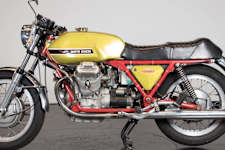Extraordinary images captured of a centuries-old galleon sunk by enemy forces reveal not only a bounty worth billions but also priceless, never-before-seen discoveries.
By John Murphy, AccuWeather staff writer
Published Jun. 13, 2022 4:01 PM EDT | Updated Jun. 13, 2022 4:05 PM EDT
A hi-tech vehicle cruising along the seafloor off the coast of Colombia on a mission to monitor the “holy grail” of colonial shipwrecks has stumbled across two more lost treasures that have been underwater for centuries.
Colombian authorities recently released extraordinary footage of the sunken 18th-century San Jose galleon that also shows two other previously undiscovered historical vessels nearby off the country's Caribbean coast.
The new discoveries include a colonial-era boat and a schooner thought to date back to around the same period as Colombia's war for independence from Spain, some 200 years ago.
"We now have two other discoveries in the same area that show other options for archaeological exploration," navy commander Admiral Gabriel Pérez told Reuters. "So the work is just beginning."
The video of the wrecks was taken during four observation missions of the San Jose ruins by the Colombian Navy, according to The Washington Post. Gold coins, crew's swords, cannons made in Seville in 1655, porcelain crockery, pottery, glass bottles and other artifacts can be seen strewn about the seafloor.
The San José was a 64-gun galleon that was sunk by the British in 1708 near Colombia's Caribbean port of Cartagena. Only a handful of its 600-strong crew survived.

The San José galleon was sunk by the British in 1708.(Wikimedia Commons)
There the ship lay at the bottom of the ocean for centuries until, in 2015, a group from the Woods Hole Oceanographic Institution in Falmouth, Massachusetts, found the wreckage. A salvage operation has yet to take place, with Colombian President Ivan Duque saying last week that the wreck has been "kept intact and protected with a view towards a future retrieval."
Naval officials used a remotely operated vehicle at a depth of around 3,100 feet to record the unprecedented footage, offering a unique glimpse into the history of the ships.

Newly released wreckage footage by Colombian authorities. (Amaze Lab)
“Every wreck is like a little Pompeii — it’s a snapshot of society at one specific time,” Leonardo Moreno-Álvarez, a graduate student at the University of Pittsburgh, told The Washington Post.
For years, the wreckage of the San Jose was long considered one of history's enduring maritime mysteries, according to ABC Australia.
When the wreck was discovered seven years ago, then Colombian President Juan Manuel Santos lauded it as "the most precious treasure ever found in the history of the world."
Experts estimate the roughly 200 tons of gold, silver, and jewels on board the San Jose is worth around $17 billion today, according to France 24.
This wealth has earned the ship the nickname of the "holy grail" of shipwrecks. But the question of ownership of the wreckage and its contents soon sparked legal disputes.

Newly released wreckage footage by Colombian authorities. (Amaze Lab)
Litigation has ensued between Colombia, Spain, an American company and the Qhara Qhara Indigenous group.
Spain, citing a UNESCO convention, claims it owns the rights to the destroyed ship because it belonged to the Spanish navy in 1706 when the ship sank. However, the Qhara Qhara Indigenous group in Bolivia says it owns the treasure because the Spanish forced their ancestors to mine some of the precious metals that were aboard.
"All those debates about archaeology are also debates about colonialism," Moreno-Álvarez told The Washington Post.
Have the app? Unlock AccuWeather Alerts™ with Premium+
And then there's the American company Sea Search Armada, which claims a share of the treasure belongs to them due to a Colombia court ruling in 2007 that entitled the company to 50% of the treasure that was discovered from the shipwreck that wasn't national patrimony.
But Colombia said that the sunken ship that had been discovered in 1981 by a company taken over by Sea Search Armada was in fact not the San José. The actual ruins of the San José, Colombian officials argued, were discovered in November 2015 with the help of the Woods Hole Oceanographic Institution. Researchers used an autonomous underwater vehicle, REMUS 6000, to help the pinpoint the wreckage's location and take images of the rubble some 1,968 feet (600 meters) deep in the water, according to ABC Australia.

Newly released wreckage footage by Colombian authorities. (Amaze Lab)
Because Colombia said the location provided by Sea Search Armada in 1981 was incorrect, it believes the company doesn't have rights to the treasure. A law Colombia passed in 2013 declaring sunken ships discovered in the country's waters are considered national heritage further cemented the fate of the San Jose and its bounty.
The new footage of the San José galleon unveiled the clearest view yet of the wreck and the treasures inside. Old rusted coins can be seen scattered across the floor of the sea, and even pottery shards and pieces of many shapes and colors are scattered around the sunken ruins.
Earlier this year, Colombian officials said all of the artifacts from the San José would eventually be displayed in a museum once salvage and cleaning operations are completed.
Officials said the contents from the other two shipwrecks will be further identified and appraised.

In this Dec. 5, 2015, file photo, Ernesto Montenegro, director of the Colombian Institute of Anthropology and History of Colombia, talks to the media while he shows a picture of remains of the Galleon San Jose in Cartagena, Colombia. (AP Photo/Pedro Mendoza, file)
MORE TO SEE:
Want next-level safety, ad-free? Unlock advanced, hyperlocal severe weather alerts when you subscribe to Premium+ on the AccuWeather app. AccuWeather Alerts™ are prompted by our expert meteorologists who monitor and analyze dangerous weather risks 24/7 to keep you and your family safer.







No comments:
Post a Comment